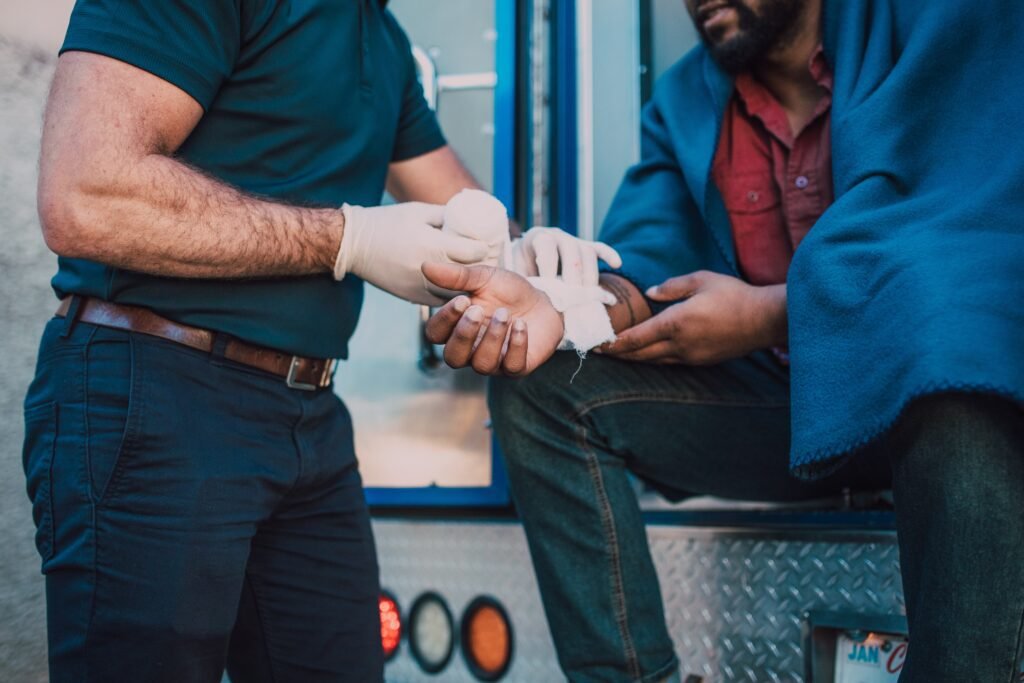How to treat an Open wound?
Open wounds are damage to the external or internal body tissues caused by casualties with sharp or hard objects. It results in minor or deep cuts or skin punctures. If left untreated, it may result in other health complications. Like other injuries, open wounds are also classified into different types. You can keep yourself and others safe by identifying the types of wounds and treatments.
What are the types of wounds?
Abrasions
These open wounds happen when your skin rubs against a rough surface. Being not so deep, there is little to no bleeding.
Incision
It’s a neat and straight cut caused by a knife or broken glass. These are similar to the cuts doctors make when performing surgery, but they can be lethal if severe, like in road accidents.
They may include,
Minor cuts: They can be easily treated at home without medical care. Check out the howtothings.net article on how to treat minor scratches for more details.
Facial cuts: They need expert care to prevent scarring.
Cut arteries: It causes bright red bleeding, and it’s essential to receive medical help to avoid blood loss.
Deep cuts: in this case, bleeding does not stop after a few minutes of pressure.
Bone or tendon cuts: Wounds where you cannot move or feel a body part and possibly cause permanent loss.
Puncture wounds
These are hole-shaped wounds caused by pointy objects such as needles or nails and are harmless. However, deep punctures like gunshot wounds require immediate medical treatment.
Laceration
Its deep and uneven cut results in skin cracks and heavy bleeding. Examples include cuts with heavy machinery, sharp tools, or knives.
Avulsions
They happen during brutal car accidents or explosions and result in partial to complete tears of the skin and underlying tissues. It causes heavy bleeding and cannot be stitched closed because the tissue is missing.
Amputation
Loss of extremities like arms, fingers, or legs due to a severe accident is called amputation. It’s similar to the amputation that a doctor performs to remove parts of your body that are infected with gangrene.
How to treat an open wound?
Minor cuts can be treated at home and don’t need follow-ups. However, severe cases require emergency services. If you or someone is severely wounded, you’ll need to conduct first aid. First, clean the wound with water, then apply pressure with a clean cloth or gauze to stop the bleeding. If the bleeding is severe, focus on stopping the bleeding first and take the victim to a hospital for emergency treatment.
Apply pressure to stop the bleeding
Don’t panic if you see a lot of blood, as you can be a lifesaver. Instead, check the open wound for debris and remove them. Avoid eliminating anything that is stuck in the damage. Pulling out objects increases blood loss and makes the injury more serious.
Apply pressure on the wound by using gauze or any clean cloth in your hand to stop bleeding. Make sure to avoid protruding objects that are embedded in the damage.

First aid treatment on the accident site
Move the victim to a safe place: Skip this step if you notice broken bones and wounds in the victim’s body. You can also skip this step if the victim is lying on a flat surface.
Rinse the wound with water: The best option is to place the wounded area below the running water. However, in case of a road accident, use a water bottle to wash away the debris on the open wound.
Wash your hands: Minor wounds and skin abrasions can be easily infected, and an antibiotic ointment will significantly reduce the risk of infection. So, wash your hands with soap and water before and after you apply the lotion. Or better is to make use of latex gloves.
Apply antibiotic ointment: Use clean gauze or a cotton swab to apply an antibiotic ointment to the wound. If you don’t have an antibiotic ointment, you can apply petroleum jelly to the damage until help arrives.
Use steri strips to pull the edges of the open wound: Steri-strips can help the wound heal faster. Skip this step if the bleeding is severe and try to stop the bleeding first till medical help arrives.

How to stop blood flow to an open wound?
Elevate the injured part above the heart: If the victim has an injury on the arm or leg, lift the area by probing some object to reduce the blood flow to that part.
If the injured part is other than the leg or arm, help the victim to lie down straight.
Place a cloth over the wound to stop bleeding.
Take a piece of clean cloth, a shirt, or anything fabric, and place it over the wound to help reduce blood flow. It will also help prevent contamination or dirt from entering the damage.
Direct pressure allows blood clots to form: Applying direct pressure for 10 to 15 minutes by using both hands on the injured area can help speed up the clot formation and reduce bleeding.
Place more clothes over the wound: Never remove a cloth you have already applied to the injury. Instead, place 2nd, the 3rd, or more layers of clothes over the damage if the first one is soaked in blood. Keep applying pressure.
Medical treatment for an open wound
The victim will likely need medical treatment, if
- The wound is deep and re-opens
- The gap between the edges of the wound doesn’t meet
- The wound is still bleeding
- The injured part is deep enough to expose the yellow-colored adipose tissue.
- Take the victim to a doctor to stitch the wound up as soon as possible.
Be smart, and stay safe!
- See the doctor if the wound shows signs of infection like redness, pain, pus or fever.
- Have a tetanus shot if you get the wound from a rusty metal piece.
- Monitor your wound for a red streak towards the heart; it’s a sign of blood poisoning and can be lethal. Seek immediate medical help.
- Bandage the wound and change the dressing three times a day.
- Always carry a First Aid kit with you to stay safe.
The howtothing.net article on How to treat a minor cut provides similar details on how to provide first aid treatment to yourself at home and when to seek professional treatment.
Medical Disclaimer
The content of this blog post is not aimed at substituting for professional medical advice or treatment. It’s always appreciated to contact your healthcare provider before starting, shifting, or halting any health treatment.

